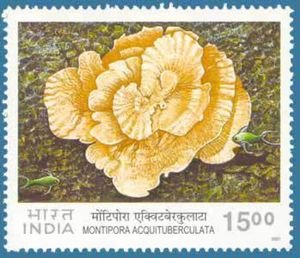Encrusting Pore Coral (Montipora acquituberculata)

Technical Data
| Stamp Set | Corals of India |
|---|---|
| Date of Issue | July 22, 2001 |
| Denomination | Rs. 15 |
| Quantity | 3,000,000 |
| Perforation | comb 13 |
| Printer | Calcutta Security Printers Ltd |
| Watermark | No Watermark |
| Colors | Multicolor |
| Catalog Codes |
Michel IN 1844 Stamp Number IN 1903 Yvert et Tellier IN 1610 Stanley Gibbons IN 2010 |
| Themes | Animals (Fauna) | Corals and Sponges | Sea Life |
Table of Contents
Encrusting Pore Coral
The Encrusting Pore Coral (Montipora acquituberculata) is a fascinating species of stony coral belonging to the Montipora genus, which is well-known for its diversity in shape and form. Here’s more about this species:
Key Characteristics:
- Growth Form: Montipora acquituberculata exhibits an encrusting growth pattern, meaning it spreads over the substrate, forming a thin, plate-like structure that closely follows the contours of the surface it colonizes. It may also exhibit irregular lobes or branches in some cases.
- Surface Texture: The coral surface is often smooth or slightly textured, with small protrusions or bumps called tubercles, giving it a characteristic appearance.
- Color: This coral can be found in various shades, including brown, green, blue, and purple. The polyps, which give the coral its porous structure, may be lighter or contrasting in color.
Habitat and Distribution:
- Montipora acquituberculata is typically found in shallow reef environments, often growing on reef flats, slopes, or in lagoons. It inhabits tropical and subtropical waters throughout the Indo-Pacific region, particularly in the Indian Ocean, parts of the Pacific Ocean, and around regions like Indonesia and Australia.
Feeding and Symbiosis:
- Like other corals, it depends on a symbiotic relationship with zooxanthellae, the algae that live within its tissues. These algae conduct photosynthesis, providing energy to the coral.
- Additionally, Montipora acquituberculata captures small plankton and organic matter using its tiny polyps, especially at night when it extends its tentacles.
Ecological Importance:
- The encrusting pore coral plays a crucial role in reef-building. Its encrusting growth form helps bind together different parts of the reef, providing structural stability and a habitat for various marine organisms.
- It contributes to the overall biodiversity of coral reefs by supporting small invertebrates and fish that find shelter in its crevices and structures.
Conservation Status:
- Montipora acquituberculata, like many coral species, faces significant challenges from climate change, ocean acidification, coral bleaching, and pollution. These factors threaten its long-term survival, making the protection of coral reef ecosystems critical.
This species, with its encrusting form and vibrant colors, adds to the rich complexity of coral reefs while serving essential ecological functions.
